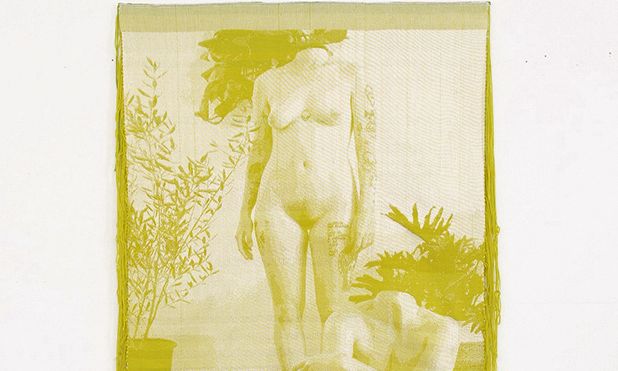Mia Weiner’s Caryatid (2022) is at Mama Projects’ stand at Future Fair
Courtesy Mama Projects
For its bright and bubbly fourth edition, Future Fair (until 4 May), the co-operative-minded, painting-forward Frieze satellite fair, is featuring a panoply of femme figurations in various forms of blissful disarray at the Chelsea Industrial space. In a cultural moment marked by gender instability and mounting pushback to minority rights, the image of a tangled or cropped body takes on a distinctly political charge, but the artists have managed to keep things light, underscoring the offbeat joy in liminal existence.
Montreal’s Duran Mashaal is featuring Rosalie Gamache, whose smooth, mucosal paintings (priced from around $1,000 to $10,000) portray radioactively melting figures in dramatic close-up, alongside the works of Oriele Steiner, whose cartoon-like compositions (priced above $5,000) swirl orange limbs into jumbled, planar tectonics. Milanese exhibitor C+N Canepaneri is showing the furious slapstick figures of Deng Shiqing ($4,900-$6,200). The Montreal-based Wishbone Gallery is showing Magali Cazo’s inky, melancholy figures ($2,100-$4,360).
On the stand of the New York gallery Hashimoto Contemporary, Genevieve Cohn’s tactile brushstrokes cohere into a bird’s-eye view of thick, green toes ($2,000-$16,000). The digital artist Lorna Mills, whose showcase with Transfer gallery sold out before the fair even opened, stuns with a four-channel GIF installation, Yellowwhirlaway (2017), in which a pixelated pair of disembodied legs swims through the flotsam and jetsam of digital culture. (Another digital work by Mills, Petting Zoo: Epic Biblical from 2020, is still available, at $15,000.)
Perhaps the fair’s most haunting fare are the acrylic tapestries of the Los Angeles-based textile artist Mia Weiner, on the stand of New York-based Mama Projects. Caryatid (2022, priced at $10,000), a tightly woven image of two headless, nude women articulated in hazy puce thread, borrows its title from the term for a sculpted female figure used to support the entablature of ancient Greek monuments. As the piece succumbs to the fate of its floor-hanging fringe, viewers are encouraged to contemplate the weight of women’s often-uncredited artisanal labour throughout history.

